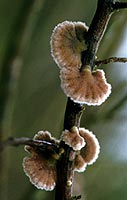|
 Species
Diversity Species
Diversity
One way to measure
diversity is simply to count all of the different life forms or
species known on Earth:
Number
of Species
(approx.)
|
|
|
|
5,000
|
|
Bacteria
|
|
58,000
|
|
Algae
& Protozoa
|
|
47,000
|
|
Fungi
|
|
248,000
|
|
Plants
|
|
1,033,000
|
|
Animals
|
|
1,391,000
|
|
Total
|
This totals nearly one-and-a-half
million known species. That's a lot of diversity! Let's look at
those species again in more commonly recognized groupings. About
half of Earth's known species are insects, by far the most diverse
group of living things. About 200,000 species are leafy plants like
trees, bushes, and ferns. In contrast, there are only about 18,000
species of fish, 9,000 species of birds, 6,000 species of reptiles,
and 4,000 species of mammals--which includes one species of humans.
Fungus image © 2000-www.arttoday.com
Most species that live
on land are found in the tropical rainforests that grow along the
equator: the Amazon rainforest, the Congo rainforest, and the rainforests
of Indonesia and Southeast Asia. Near the equator, the high rainfall,
warm temperatures, and abundant energy from sunlight create conditions
that support a wide variety of species. Away from the equator, to
the north or south, dryer climates, lower temperatures, and decreased
sunlight support fewer species. For example, over 1,000 different
species of trees were found living on one square kilometer in a
rainforest in Borneo, which is located near the equator. But there
are only about 700 species of trees in all of the United States
and Canada, an area of about 19 million square kilometers. Similarly,
most species that live in the ocean are found in and near coral
reefs which, like the rainforests, grow near Earth's equator.
|











